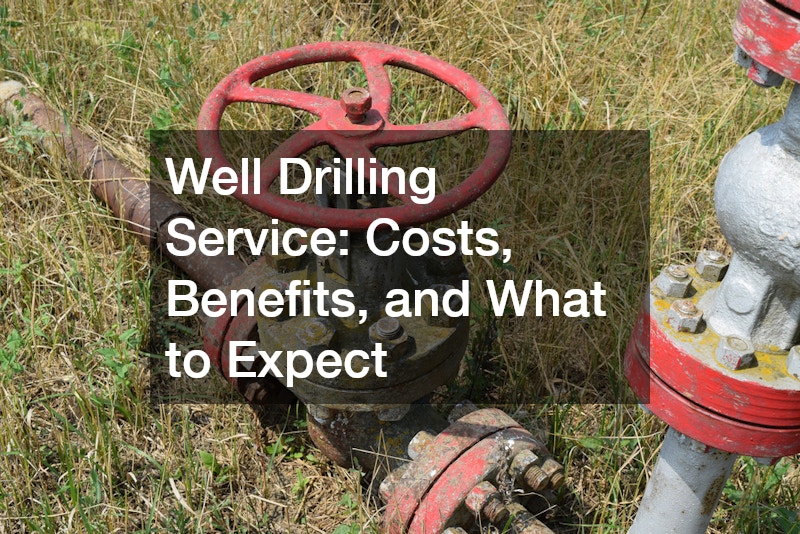The process of installing a well is essential for many rural homeowners and businesses seeking a reliable and self-sufficient water supply. Understanding well drilling service is crucial if you are considering this solution to meet your water needs. This article will delve into the costs involved, the benefits of having a well, and what you can expect from the well drilling service.
Understanding Well Drilling Service Costs
Investing in a well drilling service involves significant initial costs, but understanding these can help you prepare accordingly. Various factors influence the overall cost, including the depth of the well, the geological composition, and the required materials and equipment. Typically, the cost per drilled foot ranges from $15 to $30, which can vary based on location and the complexity of the drilling process. A thorough site assessment by the service provider is essential to provide an accurate estimate and account for any potential complications. Homeowners should budget not just for drilling, but also for additional expenses such as permits, water testing, and system installation.
In addition to the base drilling costs, various overhead expenses contribute to the total outlay for well installation. These can include labor costs, transportation of heavy equipment, and the purchase of pipe casings and pumps necessary for the well’s operation. Furthermore, well drilling services often require fees for site surveys and geological testing, which are crucial for ensuring sustainable and safe water extraction. The complexity of navigating local regulations and acquiring the necessary permits can also add unexpected costs. Therefore, a comprehensive cost-benefit analysis is recommended to ensure long-term financial viability.
Despite the high initial costs, many find that investing in a well drilling service pays off in the long term. Once the well is operational, homeowners often enjoy reduced monthly water bills and increased property value. However, unforeseen factors such as equipment failures or environmental challenges can lead to higher-than-anticipated maintenance costs. To mitigate these costs, regular maintenance and monitoring are required to ensure the well’s continued productivity and safety. Understanding these financial aspects up front can greatly enhance the decision-making process for prospective well owners.
The Benefits of Having a Well
For many, the benefits of a well outweigh the initial expenditures associated with well drilling services. One significant advantage is gaining independence from municipal water supplies, which can be unreliable or expensive. A private well grants access to a stable and continuous supply of fresh water, often enhancing the sustainability of homes and farms. In areas prone to droughts, having a well offering a reliable water source can serve as a critical lifeline. Over time, financial savings from reduced water bills can offset the initial investment and provide economic relief.
Environmental benefits also abound with well water usage. Unlike municipally supplied water, well water is naturally filtered through soil and rock, often resulting in higher purity and reduced chemical treatment requirements. This natural filtration process helps maintain the ecological balance, contrasting with the environmental impact of large-scale water treatment facilities. Furthermore, tapping into groundwater promotes a sustainable water use cycle when managed properly and responsibly. This sustainable approach can significantly reduce your carbon footprint and support environmental conservation efforts.
Finally, having a private well enhances property value and appeal. Properties equipped with a well often command higher market prices, as the prospect of unlimited, controlled access to water is an attractive feature for buyers. For those living in areas with frequent water restrictions or outages, a well provides a vital advantage. Additionally, well owners often enjoy a sense of security and autonomy knowing they are less reliant on external water sources. This level of control is particularly beneficial for agricultural operations that depend heavily on a consistent water supply for irrigation and livestock.
What to Expect from the Well Drilling Process
The well drilling process is comprehensive, often taking several weeks from the initial consultation to completion. It starts with a detailed assessment of your property’s geology, water table data, and potential well sites by experts. Once the site is selected, the drilling team will use specialized equipment to penetrate the ground, reaching aquifers that provide the water supply. This process can take from days to weeks, depending on terrain challenges and the depth required to access viable water. Throughout drilling, constant communication with the service provider is key to addressing any arising issues and ensuring the project’s smooth progress.
After drilling, casing and sealing off the well are performed to protect the water supply from contamination. The quality and installation of these casings are crucial to the long-term function and safety of the well. Once the casing is secure, the well is tested to determine its yield—the amount of water it produces over time. This phase also involves analyzing water purity to ensure it’s safe for consumption and meets local health standards. Successfully passing these tests leads to installing the necessary pumps and equipment to facilitate water delivery to your premises.

